SBVS118 August 2017 TPS7A47-Q1
PRODUCTION DATA.
- 1 Features
- 2 Applications
- 3 Description
- 4 Revision History
- 5 Pin Configuration and Functions
- 6 Specifications
- 7 Detailed Description
- 8 Application and Implementation
- 9 Power Supply Recommendations
- 10Layout
- 11Device and Documentation Support
- 12Mechanical, Packaging, and Orderable Information
Package Options
Mechanical Data (Package|Pins)
- RGW|20
Thermal pad, mechanical data (Package|Pins)
- RGW|20
Orderable Information
6 Specifications
6.1 Absolute Maximum Ratings
over junction temperature range (unless otherwise noted)(1)| MIN | MAX | UNIT | |||
|---|---|---|---|---|---|
| Voltage(2) | IN pin (VI) to GND pin | –0.4 | 36 | V | |
| EN pin to GND pin | –0.4 | 36 | |||
| EN pin to IN pin | –36 | 0.4 | |||
| OUT pin to GND pin | –0.4 | VI + 0.3 | |||
| NR pin to GND pin | –0.4 | VI + 0.3(3) | |||
| SENSE/FB pin to GND pin | –0.4 | VI + 0.3 | |||
| 0P1V pin to GND pin | –0.4 | 2.5 | |||
| 0P2V pin to GND pin | –0.4 | 2.5 | |||
| 0P4V pin to GND pin | –0.4 | 2.5 | |||
| 0P8V pin to GND pin | –0.4 | 2.5 | |||
| 1P6V pin to GND pin | –0.4 | 2.5 | |||
| 3P2V pin to GND pin | –0.4 | 2.5 | |||
| 6P4V1 pin to GND pin | –0.4 | 2.5 | |||
| 6P4V2 pin to GND pin | –0.4 | 2.5 | |||
| Current | Peak output | Internally limited | |||
| Temperature | Operating virtual junction, TJ | –40 | 145 | °C | |
| Storage, Tstg | –65 | 150 | |||
(1) Stresses beyond those listed under Absolute Maximum Ratings may cause permanent damage to the device. These are stress ratings only, which do not imply functional operation of the device at these or any other conditions beyond those indicated under Recommended Operating Conditions. Exposure to absolute-maximum-rated conditions for extended periods may affect device reliability.
(2) All voltages are with respect to the network ground terminal.
(3) The absolute maximum rating is VI + 0.3 V or 22 V, whichever is smaller.
6.2 ESD Ratings
| VALUE | UNIT | |||
|---|---|---|---|---|
| V(ESD) | Electrostatic discharge | Human-body model (HBM), per AEC Q100-002(1) | ±2500 | V |
| Charged-device model (CDM), per AEC Q100-011 | ±500 | |||
(1) AEC Q100-002 indicates that HBM stressing shall be in accordance with the ANSI/ESDA/JEDEC JS-001 specification.
6.3 Recommended Operating Conditions
over junction temperature range (unless otherwise noted)| MIN | NOM | MAX | UNIT | ||
|---|---|---|---|---|---|
| VI | Input voltage | 3.0 | 35.0 | V | |
| COUT | Output capacitor | 10 | µF | ||
| V+EN(HI) | Enable high-level voltage | 2.0 | VI | V | |
| V+EN(LO) | Enable low-level voltage | 0 | 0.4 | V | |
| IO | Output current | 0 | 1.0 | A | |
| TJ | Operating junction temperature | –40 | 145 | °C | |
6.4 Thermal Information
| THERMAL METRIC(1) | TPS7A47-Q1 | UNIT | |
|---|---|---|---|
| RGW (VQFN) | |||
| 20 PINS | |||
| RθJA | Junction-to-ambient thermal resistance | 31.1 | °C/W |
| RθJC(top) | Junction-to-case (top) thermal resistance | 21.1 | °C/W |
| RθJB | Junction-to-board thermal resistance | 10.2 | °C/W |
| ψJT | Junction-to-top characterization parameter | 0.2 | °C/W |
| ψJB | Junction-to-board characterization parameter | 10.2 | °C/W |
| RθJC(bot) | Junction-to-case (bottom) thermal resistance | 1.9 | °C/W |
(1) For more information about traditional and new thermal metrics, see the Semiconductor and IC Package Thermal Metrics application report.
6.5 Electrical Characteristics
at –40°C ≤ TJ ≤ 145°C; VI = VO(nom) + 1.0 V or VI = 3.0 V (whichever is greater); VEN = VI; IO = 0 mA; CIN = 10 µF; COUT = 10 µF; CNR = 10 nF; SENSE/FB tied to OUT; and 0P1V, 0P2V, 0P4V, 0P8V, 1P6V, 3P2V, 6P4V1, 6P4V2 pins open (unless otherwise noted)| PARAMETER | TEST CONDITIONS | MIN | TYP | MAX | UNIT | |||
|---|---|---|---|---|---|---|---|---|
| VUVLO | Undervoltage lockout threshold | VI rising | 2.67 | V | ||||
| VI falling | 2.5 | |||||||
| V(REF) | Reference voltage | V(REF) = V(FB), | 1.4 | V | ||||
| VUVLO(HYS) | Under-voltage lockout hysteresis | 177 | mV | |||||
| VNR | Noise reduction pin voltage | Using ANY-OUT option | VOUT | V | ||||
| In adjustable mode only | 1.4 | |||||||
| VO | Output voltage range | COUT = 20 µF, using ANY-OUT option | 1.4 | 20.5 | V | |||
| COUT = 20 µF, using adjustable option | 1.4 | 34 | ||||||
| Nominal VO accuracy | TJ = 25°C, COUT = 20 µF | –1.0 | 1.0 | %VO | ||||
| Overall VO accuracy | VO(nom) + 1.0 V ≤ VI ≤ 35 V, 0 mA ≤ IO ≤ 1 A, COUT = 20 µF |
–2.5 | 2.5 | %VO | ||||
| ΔVO(ΔVI) | Line regulation | VO(nom) + 1.0 V ≤ VI ≤ 35 V | 0.092 | %VO | ||||
| ΔVO(ΔIO) | Load regulation | 0 mA ≤ IO ≤ 1 A | 0.3 | %VO | ||||
| V(DO) | Dropout voltage | VI = 95% VO(nom), IO = 0.5 A | 216 | mV | ||||
| VI = 95% VO(nom), IO = 1 A | 307 | 450 | ||||||
| I(CL) | Current limit | VO = 90% VO(nom) | 1 | 1.26 | A | |||
| I(GND) | Ground pin current | IO = 0 mA | 0.58 | 1.0 | mA | |||
| IO = 1 A | 6.1 | |||||||
| I(EN) | Enable pin current | VEN = VI | 0.78 | 2 | µA | |||
| VI = VEN = 35 V | 0.81 | 2 | ||||||
| I(SHDN) | Shutdown supply current | VEN = 0.4 V | 2.55 | 8 | µA | |||
| VEN = 0.4 V, VI = 35 V | 3.04 | 60 | ||||||
| I(FB) | Feedback pin current | 350 | nA | |||||
| PSRR | Power-supply rejection ratio | VI = 16 V, VO(nom) = 15 V, COUT = 50 µF, IO = 500 mA, CNR = 1 µF, f = 1 kHz |
78 | dB | ||||
| Vn | Output noise voltage | VI = 3 V, VO(nom) = 1.4 V, COUT = 50 µF, CNR = 1 µF, BW = 10 Hz to 100 kHz |
4.17 | µVRMS | ||||
| VIN = 6 V, VO(nom) = 5 V, COUT = 50 µF, CNR = 1 µF, BW = 10 Hz to 100 kHz |
4.67 | |||||||
| Tsd | Thermal shutdown temperature | Shutdown, temperature increasing | 170 | °C | ||||
| Reset, temperature decreasing | 150 | |||||||
6.6 Typical Characteristics
at TJ = 25°C; VI = VO(nom) + 1.0 V or VI = 3.0 V (whichever is greater); VEN = VI; IO = 0 mA; CIN = 10 µF; COUT = 10 µF; CNR = 1 µF; SENSE/FB tied to OUT; and 0P1V, 0P2V, 0P4V, 0P8V, 1P6V, 3P2V, 6P4V1, 6P4V2 pins open (unless otherwise noted)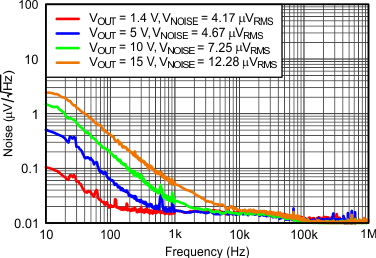
| IOUT = 500 mA, COUT = 50 µF, CNR = 1 µF, BWRMSNOISE (10 Hz, 100 kHz) |
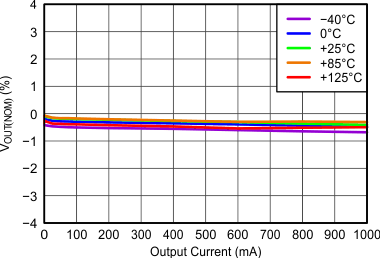
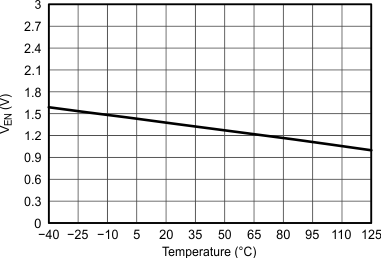
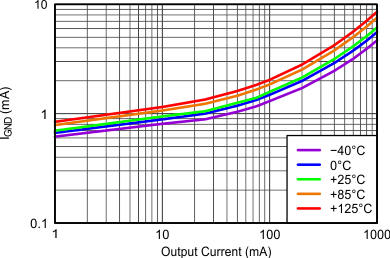
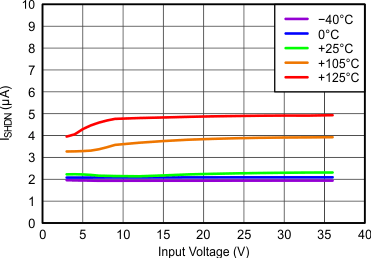
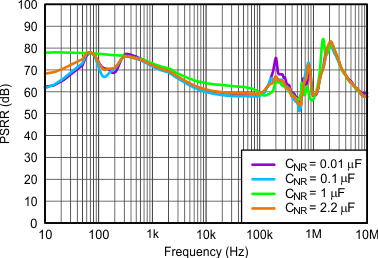
| IOUT = 1 A, COUT = 50 µF, VIN = 3 V, VOUT = 1.4 V |
Frequency and CNR
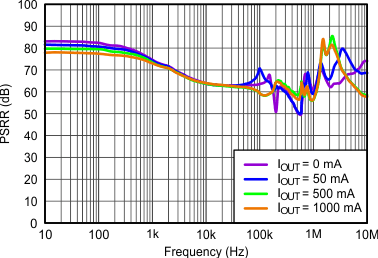
| CNR = 1 µF, COUT = 50 µF, VIN = 3 V, VOUT = 1.4 V |
Frequency and IO
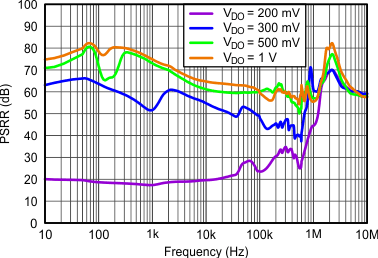
| VOUT = 3.3 V, CNR = 1 µF, COUT = 50 µF, IOUT = 500 mA |
Frequency and VDO
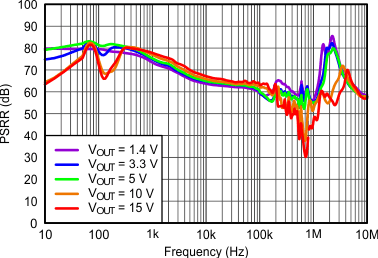
| CNR = 1 µF, COUT = 50 µF, IOUT = 500 mA |
Frequency and VOUT
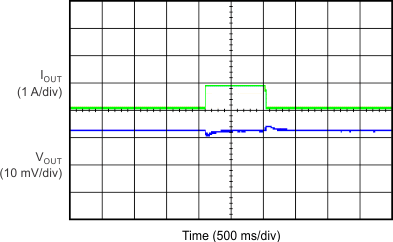
| VIN = 5 V, VOUT = 3.3 V, IOUT = 10 mA to 845 mA |
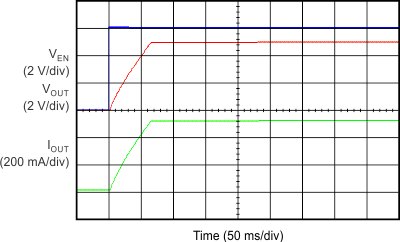
| Startup time = 65 ms, VIN = 6 V, VOUT = 5V, IOUT = 500 mA, CIN = 10 µF, COUT = 50 µF |
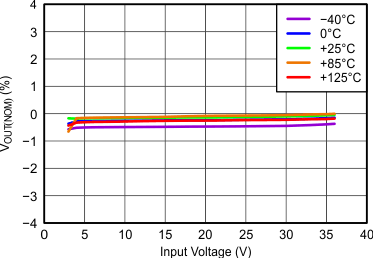
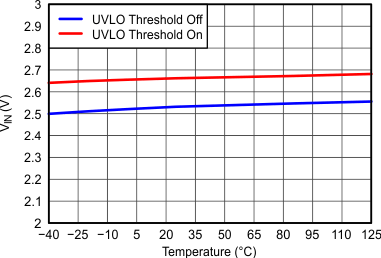
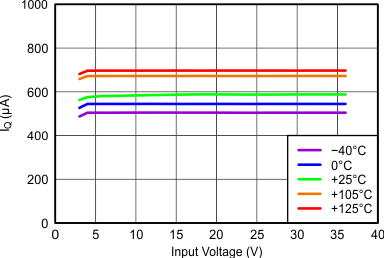
| IOUT = 0 µA |
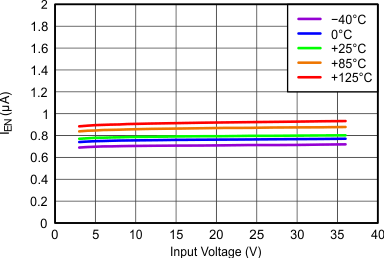
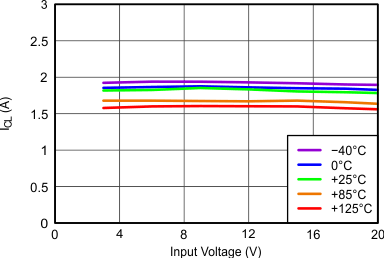
| VOUT = 90% VOUT(NOM) |
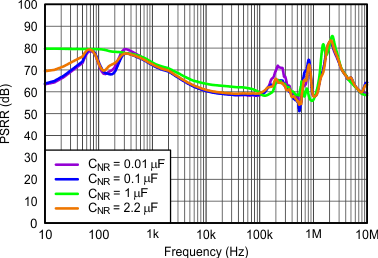
| IOUT = 0.5 A, COUT = 50 µF, VIN = 3 V, VOUT = 1.4 V |
Frequency and CNR
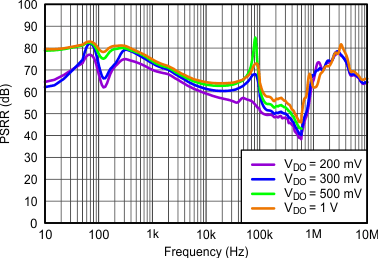
| VOUT = 3.3 V, CNR = 1 µF, COUT = 50 µF, IOUT = 50 mA |
Frequency and VDO
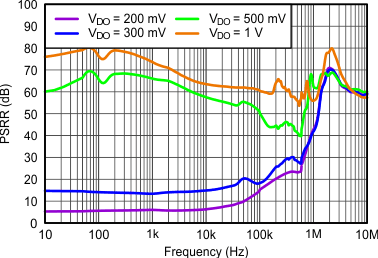
| VOUT = 3.3 V, CNR = 1 µF, COUT = 50 µF, IOUT = 1 A |
Frequency and VDO
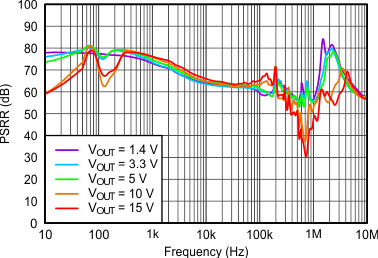
| CNR = 1 µF, COUT = 50 µF, IOUT = 1000 mA |
Frequency and VOUT
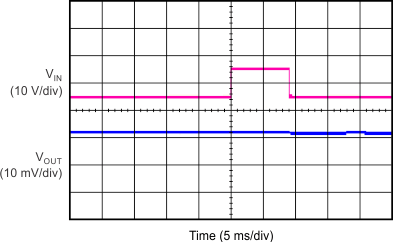
| VIN = 5 V to 15 V, VOUT = 3.3 V, IOUT = 845 mA |
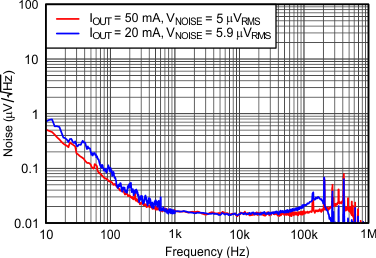
| VOUT = 4.7 V, COUT = 10 µF, CNR = 1 µF, BWRMSNOISE (10 Hz, 100 kHz) |